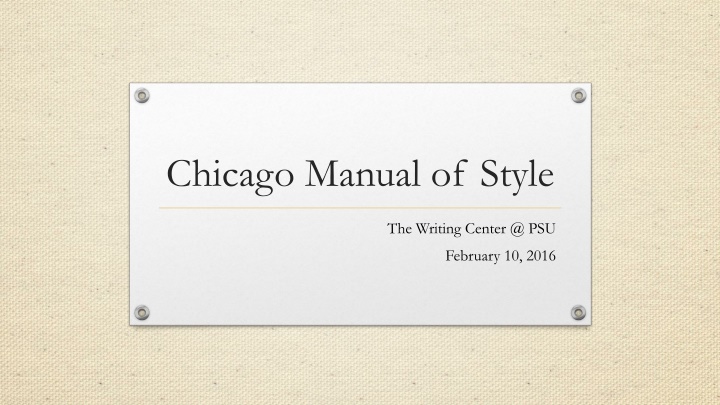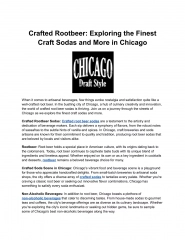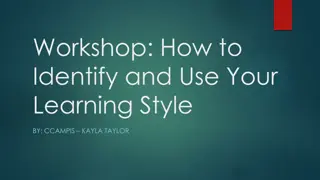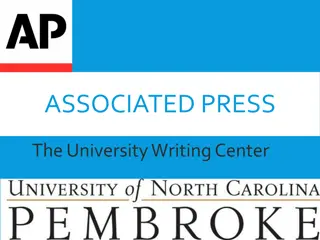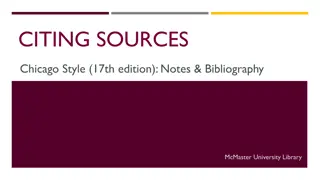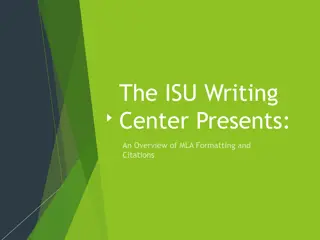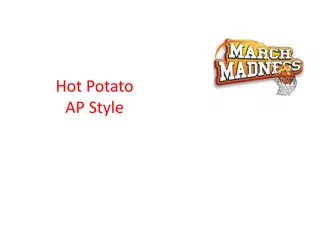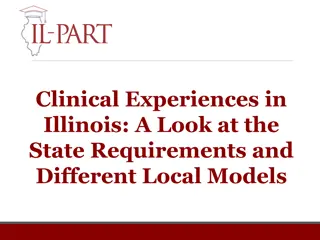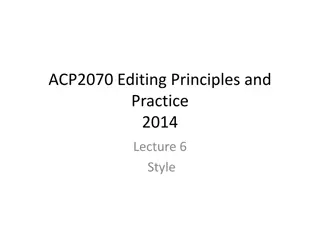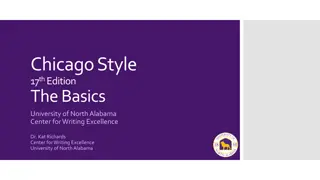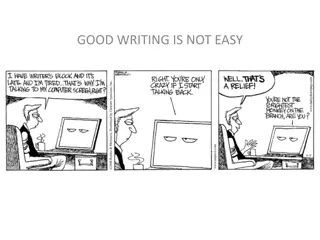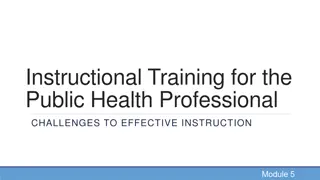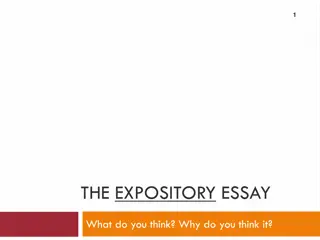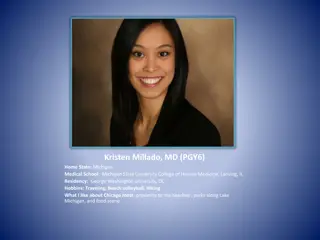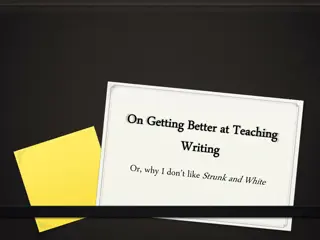Mastering Chicago Manual of Style for Effective Writing
Learn the importance of using the Chicago Manual of Style in academic writing, understand basic formatting guidelines, and explore sample papers in both Author-Date and Notes & Bibliography styles. Enhance your credibility, avoid plagiarism accusations, and structure your papers correctly for higher impact.
Download Presentation

Please find below an Image/Link to download the presentation.
The content on the website is provided AS IS for your information and personal use only. It may not be sold, licensed, or shared on other websites without obtaining consent from the author.If you encounter any issues during the download, it is possible that the publisher has removed the file from their server.
You are allowed to download the files provided on this website for personal or commercial use, subject to the condition that they are used lawfully. All files are the property of their respective owners.
The content on the website is provided AS IS for your information and personal use only. It may not be sold, licensed, or shared on other websites without obtaining consent from the author.
E N D
Presentation Transcript
Chicago Manual of Style The Writing Center @ PSU February 10, 2016
Why We Use Chicago Provide you with guidelines (a formula) for formatting essays Offer a shared set of expectations for formatting within a discipline Improve your credibility in using sources for support Help you avoid accusations of plagiarism
Basic Formatting Margins between 1 and 1.5 Typeface should be readable, such as Times New Roman or Palatino Font size should be no less than 10 pt. (preferably, 12 pt.) Text should be consistently double-spaced (only exceptions: single-space block quotes, table titles, figure captions, and notes and bibliographies internally) Notes and bibliographies should be singled-spaced internally with an extra line space between each entry Page numbers should begin in the header of the first page of text (not the title page) with Arabic number 1 Subheadings should be used for longer papers.
Sample CMS Author-Date Style Paper The link below leads to an example essay written in CMS, Author-Date style (meaning in-text citations are used as opposed to footnotes). As you look through this PowerPoint, use the example essay for reference. https://owl.english.purdue.edu/media/pdf/1300990757_717.pdf
Sample CMS Notes & Bibliography Style Paper The link below leads to an example essay written in CMS, Notes and Bibliography style (meaning footnotes are used as opposed to in-text citations). As you look through this PowerPoint, use the example essay for reference. https://owl.english.purdue.edu/media/pdf/1300991022_717.pdf
Major Paper Sections Title Page Main Body References
Title Page The title should be centered a third of the way down the page. Your name and class information should follow several lines later. For subtitles, end the title line with a colon and place the subtitle on the line below the title.
Title Your name and course information Source: Clements et al. 2011.
Main Body: Capitalization and Titles Capitalize titles in text, notes, and bibliographies in headline style Treat titles in the text as well as in notes and bibliographies with quotation marks or italics based on the type of work they name. Titles of Larger Works: Books or Periodical Titles Titles of Shorter Works: Articles or Chapter Titles Otherwise, take a minimalist approach to capitalization. Use lowercase terms to describe periods, for example, except in the case of proper nouns (e.g., the colonial period, vs. the Victorian era ).
Main Body: Block Quotes If, after typing out a quotation, it comes to five lines or longer, put the quotation in block format. Block quotes Are singled-spaced Have no quotation marks Have an extra line space immediately before and after them Are indented in their entirety .5 ****There is an example of a block quote on page 11 of the Note and Bibliography style example essay.
References In CMS formatting, there are two methods of citation: Notes and Bibliography style, and Author-Date style The two methods of citation do not affect the way sources are cited in the References/Bibliography page; however, whichever method of citation is being used determines whether that page is titled References or Bibliography
References: Formatting the Reference Page Label the first page of your back matter, and your comprehensive list of sources, Bibliography (for Notes and Bibliography style) or References (for Author-Date style). Leave two blank lines between Bibliography or References and your first entry. Leave one blank line between remaining entries. List entries in letter-by-letter alphabetical order according to the first word in each entry.
References: General Citation Format Write out publishers names in full. Do not use access dates unless publication dates are unavailable. If you cannot ascertain the publication date of a printed work, use the abbreviation n.d. Provide DOIs instead of URLs whenever possible. If you cannot name a specific page number when called for, you have other options: section (sec.), equation (eq.), volume (vol.), or note (n.).
References: Authors Use and, not an ampersand, &, for multi-author entries. For two to three authors, write out all names. For four to ten authors, write out all names in the bibliography but only the first author s name plus et al. in notes and parenthetical citations. When a source has no identifiable author, cite it by its title, both on the references page and in shortened form (up to four keywords from that title) in parenthetical citations throughout the text.
References: Books Single Author Zakharov, Prokhor. For I Have Tasted the Fruit. Sparks, Maryland:Morgan Publishing, 1999. Two to Four Authors Caldwell, Lynn, Tristan C. Landwehr, and Janet Zepernick. The Quintessential Theory of Everything. Girard, Kansas: Emanual Haldeman-Julius, 2011. More than Four Authors List normally in References/Bibliography page; in-text, list only the first author, followed by et al. Chapter or Section of a Book Kelly, John D. Seeing Red: Mao Fetishism, Pax Americana, and the Moral Economy of War. In Anthropology and Global Counterinsurgency, edited by John D. Kelly, Beatrice Jauregui, Sean T. Mitchell, and Jeremy Walton, 67 83. Chicago: University of Chicago Press, 2010.
References: Articles Journal Article Cervantes, Gabriel. "Convict Transportation and Penitence in Moll Flanders." ELH 78, no. 2 (2011): 315-336. Newspaper Article Deo, Nisha. Visiting Professor Lectures on Photographer. Exponent (West Lafayette, IN), Feb. 13, 2009. Popular Magazine Article Mendelsohn, Daniel. But Enough About Me. New Yorker, January 2010.
References: Web Sources Web Page Mister Jalopy. Effulgence of the North: Storefront Arctic Panorama in Los Angeles. Dinosaurs and Robots. Last modified January 30, 2009. http://www.dinosaursandrobots. com/2009/01/effulgence-of-north-storefront-arctic.html. Blog Post Susan Woodring, September 17, 2010 (2:31 a.m.), comment on J. Robert Lennon, How Do You Revise?, Ward Six (blog), September 16, 2010 (8:39 a.m.), http://wardsix. blogspot.com/2010/09/how-do-you-revise.html.
References: Other The reference examples included in this PowerPoint is by no means all- inclusive. For further examples, check out the Purdue OWL website: https://owl.english.purdue.edu/owl/resource/717/03/
Citations single-spaced Multiple works by same author denoted by One line of space between citations Source: Clements et al. 2011.
Other Important CMS Components Headings Tables & Figures In-Text Citations (for Author-Date style) Footnotes (for Notes and Bibliography style)
Headings: Formatting L1: Centered, Bold or Italic Type, Headline-Style Capitalization L2: Centered, Regular Type, Headline-Style Capitalization L3: Flush Left, Bold or Italic Type, Headline-Style Capitalization L4: Flush left, roman type, sentence-style capitalization L5: Run in at beginning of paragraph (no blank line after), bold or italic type, sentence-style capitalization, terminal period.
Headings Example Source: Clements et al. 2011.
Tables & Figures Position tables and figures after the paragraph in which they re described. Cite the source of the table and figure information with a source line at the bottom of the table or figure. Introduce citations with the word Source(s), followed by a colon, and ended with a period. No parentheses in citation Give every table a number and a (short and descriptive) title flush left on the line above the table. Give every figure a number and a caption flush left on the line below the figure. Number tables and figures separately in the order you mention them in the text. In the text, identify tables and figures by number ( in figure 3 ) rather than by location ( below ).
Table Example Table 1: Presidents and First Ladies from 1829-1845 Year(s) 1829-1837 1837-1841 1841 President Andrew Jackson Martin Van Buren William Henry Harrison First Lady Rachel Donelson Jackson Hannah Hoes Van Buren Anna Tuthill Symmes Harrison Letitia Christian Tyler, Julia Gardiner Tyler 1841-1845 John Tyler Source: Our First Ladies, Whitehouse.gov. Accessed April 3, 2013. http://www.whitehouse. gov/about/first-ladies.
Figure Example Figure 1: Red River Discharge Rate Fargo Station. Source: About, California Budget & Policy Center. 2016. www.cbp.org/pdfs/2012/Test Images/Second%20Test/line-chart-template.png.
Author-Date Style Used in physical, natural, and social sciences (if in history, refer to Footnotes slides) Each time a source is used in the text, it must be cited in parentheses. Parenthetical citation comprises the author s last name, the publication date, and the page number of the source, when applicable. among all things, (Thomas 2008, 153), and Foucault (1984a) represents a powerful figure in postmodern thought because he asserts that power is what produces our reality. Ultimately for Foucault, Power was the great network of political relationships
Author-Date: Parenthesis Placement Author-Date style in CMS is similar to APA in-text citations in that if information that belongs in the parenthesis appears in the sentence s lead-in phrase, it does not have to be repeated in the parenthesis at the end of the sentences. Here are a few examples: In Harry Potter and the Chamber of Secrets, J. K. Rowling (1998) explains that Harry had never experienced fear like this before (122). (The above quote is made up. Sorry Ms. Rowling!) Sommers (2012) reasons that fear is an uncontrollable force (12-13).
Notes and Bibliography Style: Footnotes Footnotes are used in the history field in place of in-text citations. Footnotes appear at the bottom of each page in which one or more sources was/were cited. Footnotes provide the same information that is listed in the Bibliography; however, this information is presented in a different order (examples are provided in upcoming slides).
Footnotes: In the Text Note numbers begin with 1 and follow consecutively throughout a given paper. Note numbers are superscripted. Note numbers are placed at the end of the clause or sentence to which they refer, after any and all punctuation. Source: Clements et al.
Footnotes: Formatting Note numbers are full-sized, not raised, and followed by a period (superscripting note numbers in the notes themselves is also acceptable). Indent footnotes just as you would a regular paragraph (first line indented .5 from the margin; subsequent lines formatted flush left). Leave an extra line space between footnotes. Place commentary after documentation when a footnote contains both, separated by a period. In parenthetical citation, separate documentation from brief commentary with a semicolon (example on page 17 of the Author-Date sample paper). Do not repeat the hundreds digit in a page (so if you are citing information that you found ranging from pages 324 to 382 of a source, write it like this in your citation: 324-82)
Footnotes: Repeating a Footnote Each time you cite a source that you have already cited, use a shortened citation. For books, journal articles, or newspaper articles, use the author s last name, shortened source title, and the page number Grazer and Fishman, Curious Mind, 37. For websites, use the author (or corporate author), if applicable, and then the article/website title (use only the website/article title if there is no author) Bouman, Black Hole.
Footnotes: Citation Examples On the next several slides, N represents the citations for footnotes, while B represents the citations for the corresponding citations as they would appear in the Bibliography.
(N) vs. (B): Books Book by One Author (N): 1. William Faulkner, Absalom, Absalom! (New York: Vintage Books, 1990), 271. (B): Faulkner, William. Absalom, Absalom!. New York: Vintage Books, 1990. Book by Multiple Authors (N): 2. Scott Lash and John Urry, Economies of Signs & Space (London: Sage Publications, 1994), 241-51. (B): Lash, Scott, and John Urry. Economies of Signs & Space. London: Sage Publications, 1994.
(N) vs. (B): Books, contd. Book with Author and Editor (N): 3. Edward B. Tylor, Researches into the Early Development of Mankind and the Development of Civilization, ed. Paul Bohannan (Chicago: University of Chicago Press, 1964), 194. (B): Tylor, Edward B. Researches into the Early Development of Mankind and the Development of Civilization, Edited by Paul Bohannan. Chicago: University of Chicago Press, 1964. Article, Chapter, Essay, Short Story, etc., in an Edited Collection (N): 4. Peter Chilson, "The Border," in The Best American Travel Writing 2008, ed. Anthony Bourdain (Boston: Houghton Mifflin Company, 2008), 46. (B): Chilson, Peter. "The Border." In The Best American Travel Writing 2008, edited by Anthony Bourdain, 44-51. Boston: Houghton Mifflin Company, 2008.
(N) vs. (B): Periodicals Article from an Electronic Journal (N): 1. Henry E. Bent, Professionalization of the Ph.D. Degree, College Composition and Communication 58, no. 4 (2007): 141, accessed December 5, 2008, http://www.jstor.org/stable/1978286. (B): Bent, Henry E. "Professionalization of the Ph.D. Degree. College Composition and Communication 58, no. 4 (2007): 0-145. Accessed December 5, 2008. http://www.jstor.org/ stable/1978286. Article from an Online Magazine (N): 1. Barron YoungSmith, Green Room, Slate, February 4, 2009, http://www.slate.com/id/2202431/. (B): YoungSmith, Barron. Green Room. Slate, February 4, 2009. http://www.slate.com/id/2202431/.
(N) vs. (B): Periodicals, contd. Article from a Print Magazine (N): 1. Emily Macel, Beijing s Modern Movement, Dance Magazine, February 2009, 35. (B): Macel, Emily. Beijing s Modern Movement. Dance Magazine, February 2009. Article from a Newspaper (N): 1. Nisha Deo, Visiting Professor Lectures on Photographer, Exponent (West Lafayette, IN), Feb. 13, 2009. (B): Deo, Nisha. Visiting Professor Lectures on Photographer. Exponent (West Lafayette, IN), Feb. 13, 2009.
(N) vs. (B): Other Sources Blog Entry (N): 2009, 35. (B): 1. Emily Macel, Beijing s Modern Movement, Dance Magazine, February Macel, Emily. Beijing s Modern Movement. Dance Magazine, February 2009.
Resources The Purdue OWL s Chicago Manual of Style Guide The Chicago Manual of Style, 16th Edition (some content requires subscription) The Writing Center @ PSU!!
Bibliography Clements, Jessica, Elizabeth Angeli, Karen Schiller, S. C. Gooch, Laurie Pinkert, and Allen Brizee. General Format. The Purdue OWL. October 12, 2011. http://owl.english.purdue.edu/owl/resource/717/13/.
